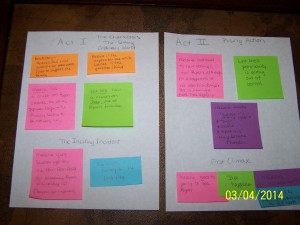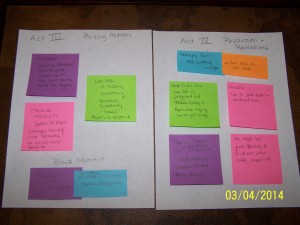I’m plotting a massive rewrite. To be completely honest, I’m feeling pretty intimidated by the size of the mess I have in front of me. But this story is one of my favorites, and it’s a really solid potential follow up to Edwin being the same teen lit type of story, so I’ve decided it needs to be done right now. My anxiety sort of brought me to a conversation with a friend, in which we discussed the usefulness of post-it notes in plotting.
I loathe post it note plotting. For first drafts anyway. I’m much more of a pantser (which is short for seat of the pants plotter for any newbies reading this), and I’m a fan of the continuous draft method of writing. I usually have only a basic idea of who the characters are and what the black moment is going to be when I start writing the first day. I spend some time introducing characters, doing exploratory writing to get into the voice, and then I establish the real world and really try to nail down my main character. Once I actually have something on the page, I’ll let it simmer on the back burner for awhile. When I feel ready, I’ll reread and edit what I’ve written, and then I think about what might happen next to move toward the black moment I have in mind. Then the following day, I reread and edit from the beginning again, adding on or trimming as I go. This is how a book gets written in my world. I know a lot of people who swear by the mantra “Just Write Anything” for their first draft. But I can’t do that. I have to identify one turning point at a time to get me toward my black moment. I have to polish as I go. As a result, my first drafts usually take longer, but they’re pretty clean and readable. I can’t actually force anything to happen, I just let the characters do what comes naturally to them and I love the surprises I get.
But sometimes when I get that first draft done, I do discover problems. Some of those problems can be fatal, meaning the manuscript should probably never see the light of day. But other times, it’s something like voice. Or maybe the plot would pack more punch if the characters were a different age or had a different hobby. Or in the case of this particular rewrite, the whole story just doesn’t feel urgent enough—it seems too easy to put down.
Urgency is usually created by the tension between how much you care about the characters and the rate at which you’ve thrown conflict at them. If anyone tells you your story is really good, but something doesn’t feel urgent enough, I’d start with looking at those items. I lucked out. I received feedback that my characters were great, so I know I need to work on plot construction. And since this is an angsty story, I know there is enough conflict, so my problem has got to be about pacing. It’s about the rate at which I present the conflict to the characters.
Which leads me back to those damn post-its. They might be a spontaneity killer, but this is an organizational problem, and those things are awesome at keeping you organized.
First thing I did was make a decision about a plot structure. I think a four act structure is going to be ideal, so I created four sheets of paper. It also has considerable back story, which weighs heavily on the main character in the background, so I know I will need to be careful to pepper through the story as needed without dumping. Back story dumping kills pacing.
Then I began writing plot events on post its. If you’re trying this, don’t feel like you have to write down every single thing that happens—just identify major events that move the story forward. The rewrite I’m working on is a love story with two major subplots. One subplot is about the main character’s little sister, and one is a love story within the major love story which is a driving force for the catharsis of the main character AND her love interest. For maximum effect at the black moment, subplot climaxes should happen along with the mini-climaxes of the over-arching story. If you’re very visual like me, you can use a different color post it for each subplot. (I’ve seen color coded spreadsheets. Do what works.)
Then, I took all my post its and stuck them on the sheet of paper labeled with the appropriate act where I thought that action should be happening. The nice thing about the post its is that you can move them around.
When you’re done, you can literally SEE any holes in your plotlines. Or a sagging middle, with very little action. If a certain act is too full or cluttered, you might consider moving some of that action forward or back in the storyline. You can make sure your storylines are reaching turning points at or near the same time. Since I really want to pump up the urgency, I was able to identify a few places that need to be filled out in the manuscript a little more. And I was also able to identify a few items that need to be cut out entirely.
Here’s what I ended up with:
It’s not perfect, but it feels a little bit like a map. So here goes nothing.


